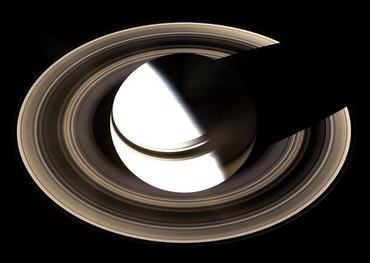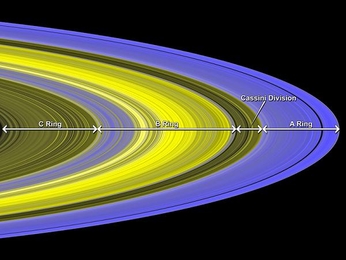 |
 |
 |
 |
 |
 |
 |
 |
|
 |
 |
 |
59 Planetary rings
|
| Menu | back |
The planetary rings of all four gas planets are demonstrably short-term phenomena. They cannot be older than 10,000 years. Since they must not have existed in context with the planets from the beginning, it is possible that the planets themselves are older. However, it is notable that the planetary rings are observed simultaneously on all four gas planets in the solar system. The uncommonly sharp delimitation of the rings is also astonishing. Since the particles in the ring continuously collide with one another, the edges should be smeared in the course of time.
One of the four gas planets is Saturn. It is surrounded by several thousand rings, which can be categorized into seven primary rings. The entire extent of the ring system is larger than the distance between Earth and moon. The manner in which these rings were formed by natural processes is a complete mystery (1). However, they cannot be very old because they disintegrate during only a few millenniums due to continuous loss of material (2).
|
 |
|
 |
| Rings of Saturn |
|
A, B and C rings of Saturn |
Different properties:
Saturns rings consist of objects, which are up to several metres in size. However, there are significant differences between the individual rings. Only few particles smaller than 5 cm are present in the B ring and the inner areas of the A ring, while they occur more frequently in the C ring and outer A ring.
Further rings have been found in the inner and outer areas of the B ring, which are several hundred kilometres wide and contain highly differing quantities of material. A thick, 5,000 km-wide core contains a number of bands in which the density is four times higher than in the A ring and nearly twenty times higher than in the C ring.
The chemical analysis of the A ring indicates unexpectedly pure grains of ice containing certain silicate admixtures toward the centre. In contrast to the relatively unstructured A ring and the wavy structure present in the C ring, the B ring shows numerous additional structural characteristics (3).
Conclusion:
The notion that these rings developed through natural processes is hardly plausible. They give the impression that for some reason they were formed and structured in precisely the manner we see them today.
These 60 | Menu |
back
|
References:
|
| (1) |
Stephen Battersby, First images of Saturn´s rings bring surprises, New Scientist Nr. 2455, 10 July, 2004. |
| (2) |
Norbert Pailer und Alfred Krabbe, Der vermessene Kosmos, Hänssler, 2006, page 136. |
| (3) |
Hans Zekl, Cassini: Der Stoff, aus dem die Saturnringe sind, astronews.com, 30 May, 2005,
http://www.astronews.com/news/artikel/2005/05/0505-020.shtml. | |
| |
| (Images) http://www.reuzenplaneten.nl/ringen.htm |
| |
Comment this Site!
|
 |
 |
 |
 |
|

